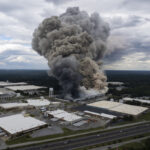Major repairs are done and production is back to pre-storm levels at Southwest Louisiana’s 23 biggest chemical plants and oil refineries – but Hurricane Rita did about $150 million in damage to the plants alone, an industry group said.
“This is just the cost to repair the plant. It’s not the cost of lost raw material and the process of shutting down and starting back up,” said Larry DeRoussel, executive director of the Lake Area Industry Alliance.
Production fell about 3.1 million tons after the Sept. 24 hurricane, according to a report prepared by McNeese State University professors Michael Kurth and Daryl Burckel for the LAIA, which released it Aug. 22.
“All in all, considering the force of the hurricane, there was a lot of damage, but at the same time it was not as bad as it could have otherwise been,” DeRoussel said. “I think it also spoke to the design integrity of the plants, as to what they can handle and what they can hold up to.”
High utility prices and a shrinking labor force had hit the industry hard before Hurricane Rita. Full-time employment at the plants fell for the fifth straight year but appears to be stabilizing, the report says. Contract workers increased in 2005 because of hurricane repairs.
There were 6,401 regular workers on plant payrolls in 2005, 71 fewer than 2004. Nearly 2,000 industry jobs have been lost since 2001.
“Part of this was driven by technology and a lot of it was driven by the fact that other costs are going up that we have no control over,” DeRoussel said. “We have to look for other innovative ways to reduce our costs to be competitive in the global market.”
A key factor has been the rising cost of natural gas, which most plants use as raw material for manufacturing or as fuel to run their facilities. It also dramatically affects the industries’ utility bills.
The LAIA plants’ 2005 utility bills totaled $1.25 billion, 18 percent higher than the previous year.
Wages and benefits increased slightly in 2005 to $768.8 million. The average plant worker salary, including benefits, was $120,114, the study says. Rising health-care costs will likely continue to push that up at a faster rate than inflation, the study says.
Charitable donations by LAIA members increased by $1.4 million to $4.7 million. That figure does not include corporate donations to state relief efforts, DeRoussel said.
Spending on goods and services within a 50-mile radius of Lake Charles totaled $992 million, a 2 percent increase.
Kurth and Burckel estimate the petrochemical industry’s payroll and spending creates 43,527 indirect jobs.
“If you remove those petrochemical plants from our economy you’d be removing … over half of the local jobs in our economy,” Kurth said.
Industry officials are projecting a labor shortage in the coming years, particularly among skilled workers like electricians. DeRoussel said plants will also need to hire more than 500 operators over the next five years, assuming no major expansions.
Technology has increased the qualifications for an operator, making it harder to replace workers as they retire.
Every plant safely shut down operations quickly and completely before Rita hit.
“The plants shut down totally and started back up with no injuries to any of their employees or contractors, and there were no environmental incidents,” DeRoussel said.
“I think the industry was prepared before, and they are even better prepared now to handle these types of situations,” he said.
Information from: American Press, www.americanpress.com.
Was this article valuable?
Here are more articles you may enjoy.

 Verlan Files Subro Suit Against Georgia Chemical Plant After $20M Payout on Fire
Verlan Files Subro Suit Against Georgia Chemical Plant After $20M Payout on Fire  Losses Top $20 Billion in Asia Floods as Climate Risks Grow
Losses Top $20 Billion in Asia Floods as Climate Risks Grow  Tricolor Trustee Plans to Sue Founder for Auto Dealer’s Collapse
Tricolor Trustee Plans to Sue Founder for Auto Dealer’s Collapse  State Farm Sued Over Policies Backed by Distressed Insurer PHL
State Farm Sued Over Policies Backed by Distressed Insurer PHL 